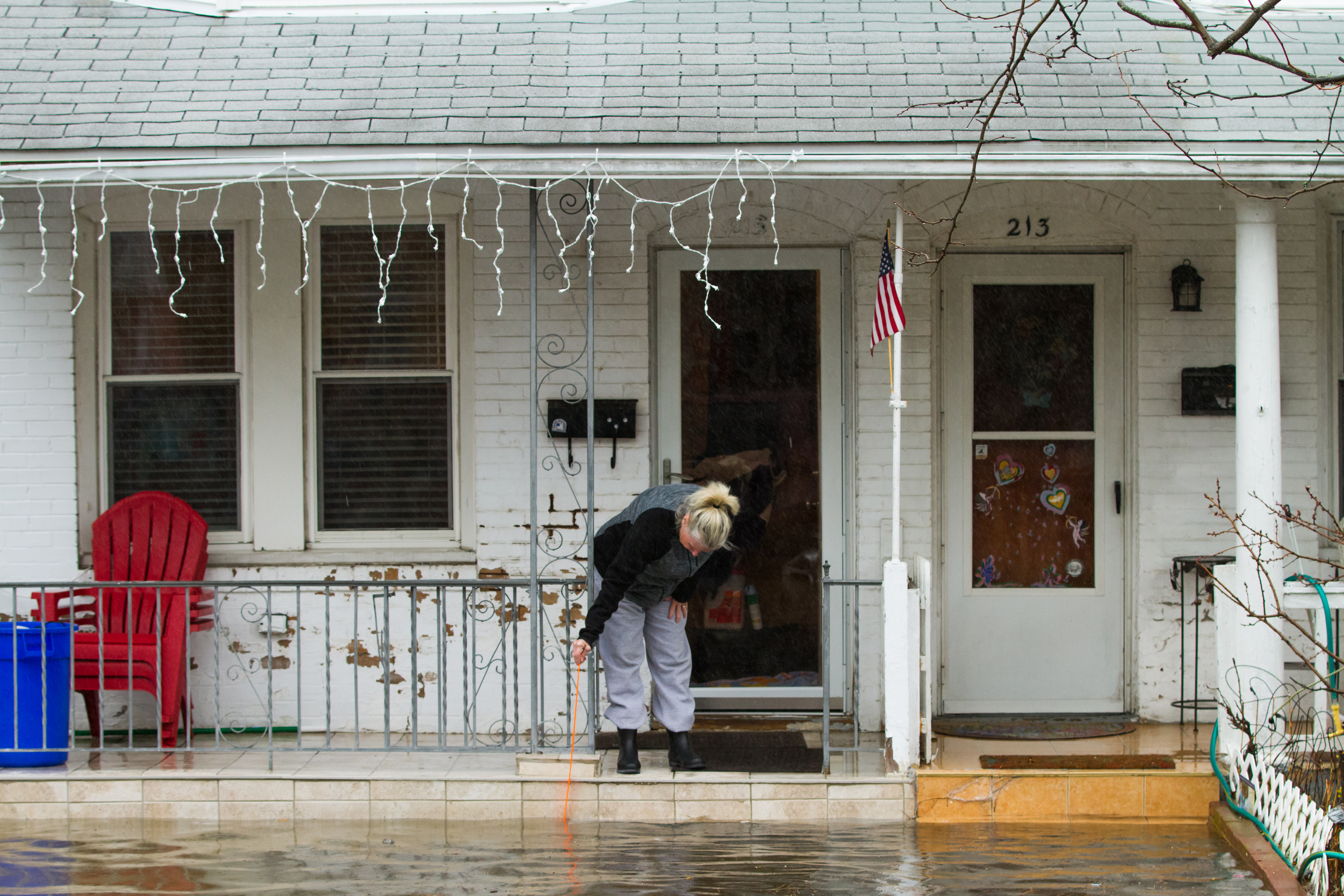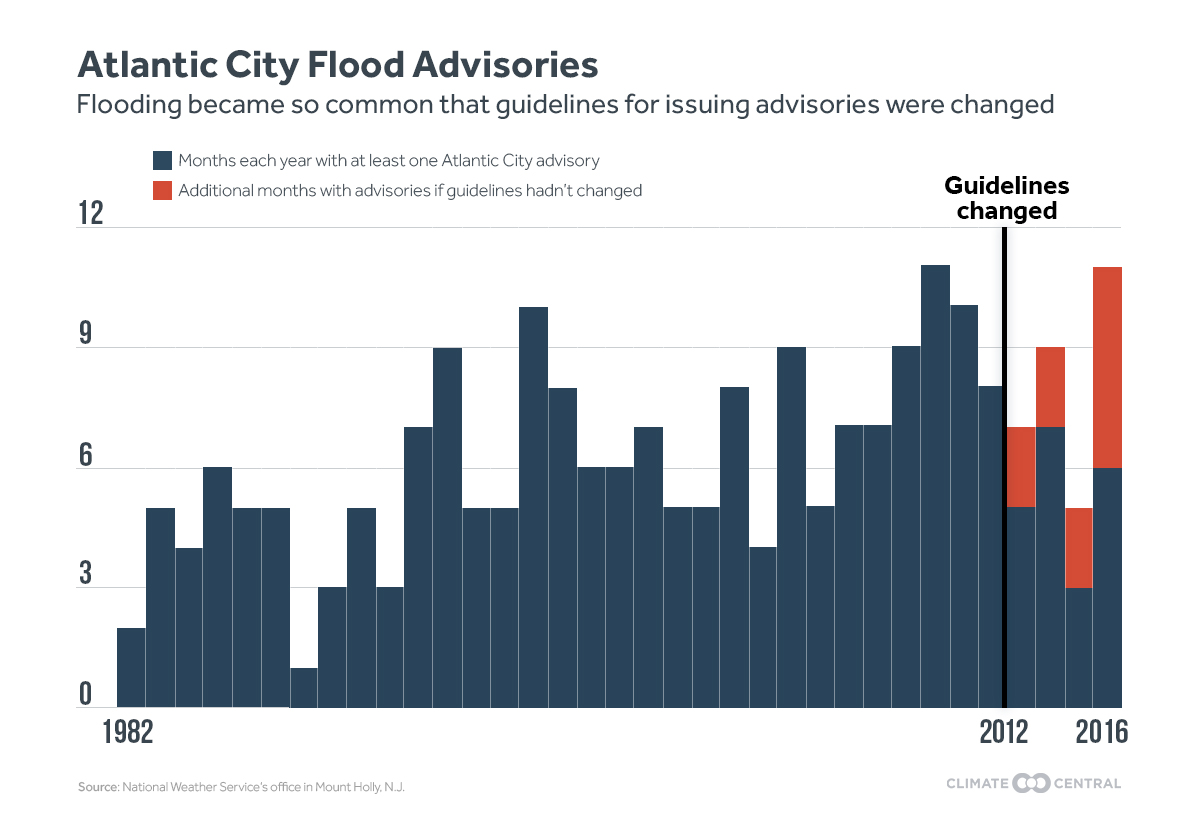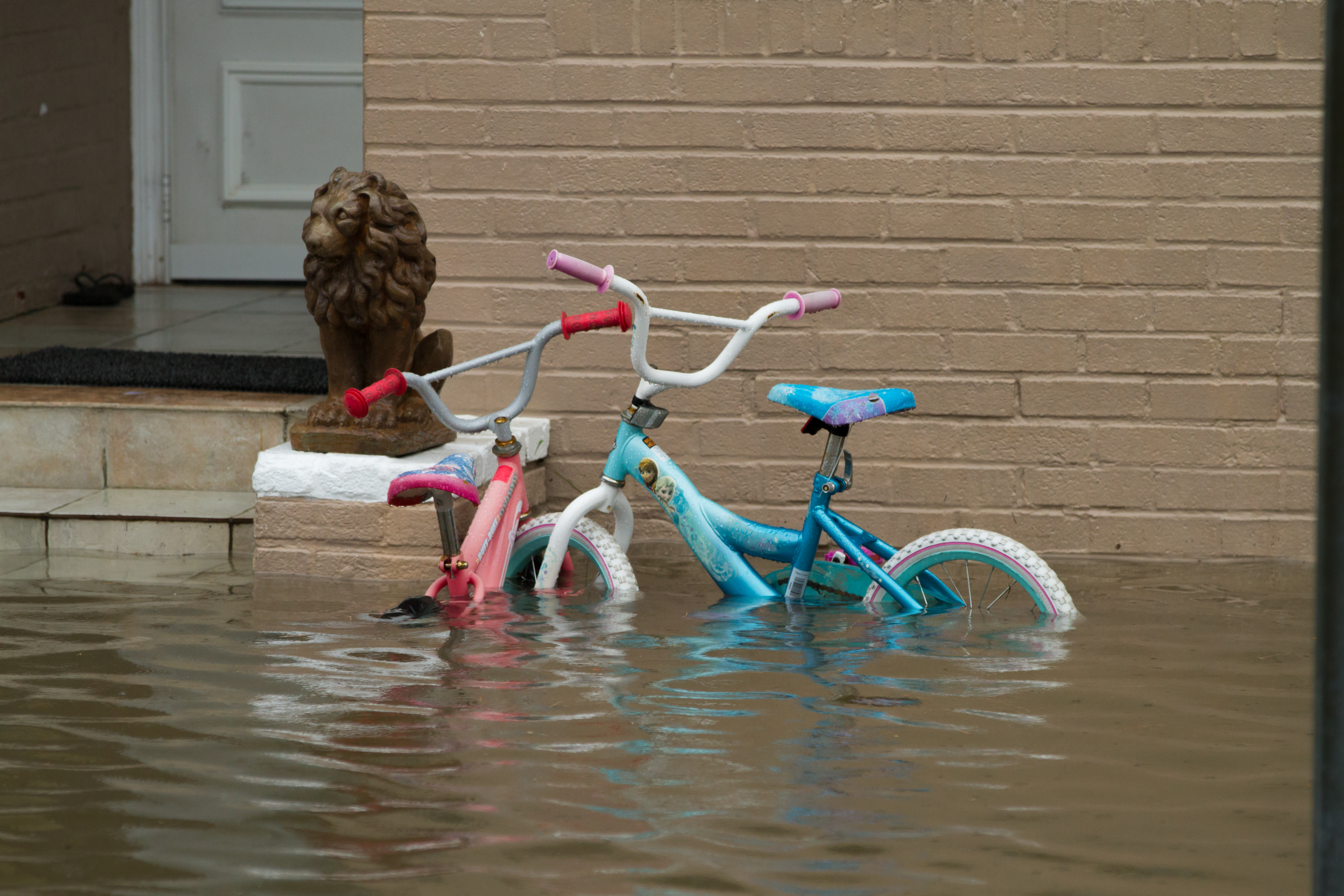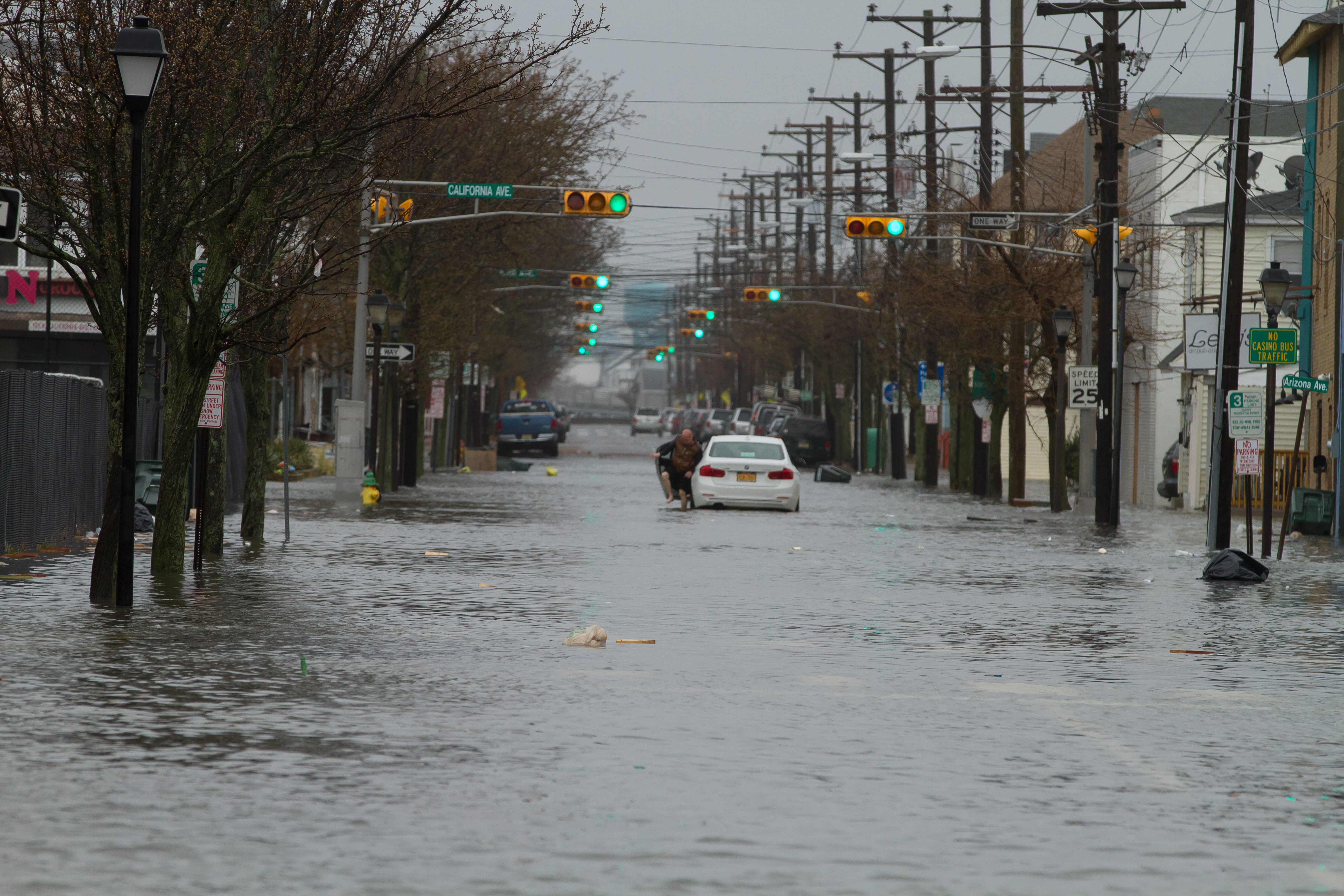By John Upton
May 10, 2017
ATLANTIC CITY, NJ - A driver plowed a sedan forcefully up Arizona Avenue, which had flooded to knee height during a winter storm as high tide approached. The wake from the passing Honda buffeted low brick fences lining the tidy homes of working-class residents of this failing casino city, pushing floodwaters into Eileen DeDomenicis’s living room.
“It wasn’t bad when we first moved in here — the flooding wasn’t bad,” DeDomenicis said on a stormy morning in March, after helping her husband put furniture on blocks. She counted down until the tide would start to ebb, using a yardstick to measure the height of floodwaters climbing her patio stairs. She was tracking how many more inches it would take to inundate the ground floor. “When somebody comes by in a car, it splashes up. It hits the door.”
DeDomenicis has lived in this house since 1982, a few hundred feet from a bay. She used to work as a restaurant server; now she’s a school crossing guard. Her husband walked a mile to his job at Bally’s Casino until he retired in January. They’ve seen floods worsen as the seas have risen, as the land beneath them has sunk, and as local infrastructure has rotted away. “It comes in the front door, the back door, and then from the bottom of the house, in through the sides,” DeDomenicis said. “You watch it come in and it meets in the middle of the house — and there’s nothing you can do.”

Eileen DeDomenicis on the patio of her home on Arizona Avenue as a high tide and rain cause flooding in parts of Atlantic City. Credit: Ted Blanco/Climate Central
Two miles east of Arizona Avenue, the U.S. Army Corps of Engineers is spending tens of millions of dollars building a seawall to reduce storm surge and flooding risks for Atlantic City’s downtown and its towering casinos, five of which have closed in the past four years. A few miles in the other direction, it’s preparing to spend tens of millions more on sand dunes to protect million-dollar oceanfront homes.
But the federal government has done little to protect the residents of Arizona Avenue, or the millions of other working class and poor Americans who live near bays up and down the East Coast, from a worsening flooding crisis. Seas are rising as pollution from fossil fuel burning, forest losses and farming fuels global warming, melting ice and expanding ocean water. With municipal budgets stretched thin, lower-income neighborhoods built on low-lying land are enduring some of the worst impacts.
Climate Central scientists analyzed hundreds of coastal American cities and, in 90 of them, projected rapid escalation in the number of roads and homes facing routine inundation. The flooding can destroy vehicles, damage homes, block roads and freeways, hamper emergency operations, foster disease spread by mosquitoes, and cause profound inconveniences for coastal communities.
Atlantic City is among those facing the greatest risks, yet much of the high-value property that the Army Corps is working to protect was built on a higher elevation and faces less frequent flooding than neighborhoods occupied by working class and unemployed residents — an increasing number of whom are living in poverty.
Low walls called bulkheads built along Atlantic City’s shores to block floods have washed away, or were never built in the first place. Flap valves in aging storm drains have stopped working, allowing water to flow backward from the bay into the street when tides are high. At high tide, stormwater pools in Arizona Avenue, unable to drain to the bay. The flooding is getting worse because seas have been rising along the mid-Atlantic coast faster than in most other regions, and the land here is sinking because of groundwater pumping and natural processes. High tides in Atlantic City reach more than a foot higher than they did a century ago and sea level rise is accelerating.
New Jersey has done little to address the problem, aside from administering federal grants that have helped a limited number of residents abandon or elevate vulnerable houses. “We expect each town to focus on planning and budgeting for mitigating flooding,” said New Jersey Department of Environmental Protection spokesman Bob Considine. Atlantic City can nary afford the kinds of capital improvements needed to provide meaningful relief.
The Army Corps last year began a study of bay flooding in a sweeping stretch of New Jersey covering Atlantic City and 88 other municipalities, home to an estimated 700,000. The study was authorized by Congress in 1987, but it wasn’t kickstarted until federal research identified widespread risks following Superstorm Sandy.
Video by Ted Blanco
The bay flooding study is “fairly early in the process,” said Joseph Forcina, a senior Army Corps official who is overseeing more than $4 billion worth of post-Sandy recovery work by the agency, including construction of a $34 million seawall in downtown Atlantic City and tens of millions of dollars worth of sand dune construction and replenishment nearby. The study is expected to take more than two years. “We really are in the data-gathering mode.”
The study will help the agency propose a plan, which Congress could consider funding, to ease flood risks when high tides and storms push seawater from bays into streets and homes. It will consider the effects of sea level rise but it won’t directly address flooding from poor drainage of rainwater, meaning any fixes spurred by the study are likely to be partial at best. “The Corps is not the agency that deals with interior drainage,” Forcina said. “That’s a local responsibility.”
Floods are driving up insurance rates, while routinely causing property damage and inconveniences. Federal flood insurance promotes coastal living in high-risk areas, and the program is more than $20 billion in arrears following Hurricane Katrina and Sandy. Arizona Avenue residents received Federal Emergency Management Agency letters in March warning of insurance rate increases ahead of 5 to 18 percent a year, which “makes us want to leave even more,” said Tom Gitto.
Raising three children on Arizona Avenue, Gitto and his wife have been unemployed since the closure last year of Trump Taj Mahal, where they worked. He said the flooding has become unbearable but property prices are so low that they feel trapped. Two houses on Arizona Avenue recently sold for less than $35,000. Gitto paid a similar price for his fixer-upper in the 1990s, then spent more than the purchase price on renovations. Flood insurance provided $36,000 for another refurbishment after Sandy ravaged their home.
Flooding strikes the Jersey Shore so often now that the National Weather Service’s office in Mount Holly, N.J., raised the threshold at which it issues flood advisories by more than 3 inches in 2012 “to avoid creating warning fatigue,” flooding program manager Dean Iovino said. Such advisories were being issued nearly every month in Atlantic City before the policy change, up from an average of four months a year in the 1980s.

One out of 10 of the 20,000 homes in Atlantic City are at elevations that put them at risk of flooding each year on average, Climate Central found, though some are protected by bulkheads and other infrastructure that help keep floods at bay. The research was published Wednesday in the journal Climatic Change.
The proportion of the city’s streets and homes affected by flooding is projected to quickly rise. Within about 30 years — the typical life of a mortgage — one out of three homes in Atlantic City could be inundated in a typical year. That would be the case even if aggressive efforts to slow climate change are put in place, such as a rapid global switch from fossil fuels to clean energy.
The worsening woes aren’t confined to Atlantic City, though risks here are among the greatest in America. Neighborhoods near bays can experience rapid increases in the number of streets and homes exposed to regular floods, with small additional sea level capable of reaching far into flat cityscapes and suburbs.
Elsewhere at the Jersey Shore, in Ocean City, N.J., the analysis showed one out of five homes are built on land expected to flood in typical years, a figure that could rise to nearly half by 2050. Other cities facing rapid increases in risks include San Mateo along San Francisco Bay in Silicon Valley, the lumber town of Aberdeen at Grays Harbor in Washington state, and Poquoson, Va., which has a population of 12,000 and juts into the Chesapeake Bay.
The greenhouse gas pollution that’s already been pumped into the atmosphere makes it too late to prevent coastal flooding from getting worse. It’s simply a matter of how much worse.
The benefits of acting now to slow the effects of warming later would become clearest in the second half of this century. In Atlantic City, if global pollution trends continue and defenses are not improved, 80 percent of current homes risk being inundated in typical years by the end of the century, the analysis showed. By contrast, if greenhouse gas pollution is aggressively reduced almost immediately, the number of homes expected to be exposed to that risk in 2100 would fall to 60 percent.
As efforts to protect the climate founder in the U.S. and elsewhere, unleashing higher temperatures and seas, communities like the DeDomenicises’ have three basic options for adapting. They can defend against floods with infrastructure that keeps tidal waters at bay, such as bulkheads, pumps, and marsh and dune restorations. They can accommodate the water using measures such as elevating existing houses and building new ones on stilts. And they can relocate altogether, an option that’s expected to lead to mass migrations inland during the decades ahead.
Modeling by University of Georgia demographer Mathew Hauer projects 250,000 being forced by rising seas from New Jersey by century’s end if pollution levels remain high, with nearly 1.5 million refugees fleeing to Texas from U.S. coasts elsewhere. And from Florida — the poster child for sea level dangers in the U.S. — 2.5 million may be driven to other states.
All three strategies are being pursued to some extent in Atlantic City. All of them are expensive, limiting the options available for a city in decline. “Cities boom and bust,” said Benjamin Strauss, coauthor of the new study and vice president for sea level and climate impacts at Climate Central, which researches and reports on climate change. “Neighborhoods can thrive, and fall into decay. Those are, to some extent, natural cycles of economic life. But now, superimposed onto that for Atlantic City at just the wrong time is this awful existential sea level threat.”

The Army Corps is building a seawall to protect downtown Atlantic City from floods caused by storm surges. Credit: Ted Blanco/Climate Central
Barrier islands like Absecon Island, upon which Atlantic City grew as a gaming and vacation mecca, line the East Coast, from New York to Florida, natural features associated with the coastline’s wide continental shelf and shallow waters. Until barrier islands were developed and armored with seawalls, roads and building foundations, low-lying shores facing the mainland could keep up with rising seas. Wind and waves washed sand and mud over growing marshes, helping to build up the land. Now a century of development has locked down the shape and position of the islands, blocking natural processes.
“It’s a huge problem for the U.S.,” said Benjamin Horton, a professor at Rutgers University in New Jersey, which is a global leader in researching sea rise. “These barrier islands are important for so many things — important for housing, important for the economy. They’re important for a variety of industries. They’re especially important for ecosystems. And the barriers protect the mainland from hurricanes; they’re a first line of defense. You lose the barrier islands and where do you think the big waves are going to hit?”
As barrier islands and mainland coastlines were developed, wealthy neighborhoods clustered near ocean shores, where the elevations tend to be higher, which reduces flood risks, and where views are considered the best. Lower-income neighborhoods and industrial zones grew over former marshlands near bays and rivers, where swampy smells are strongest and where flooding occurs most frequently.
That divide between rich and poor is clearly on display on Absecon Island, where stately houses built on higher land facing the ocean are often occupied only during summer — when risks of storms are lowest. The vacation homes and downtown Atlantic City casinos will be protected from storm surges by a new seawall and sand dunes built by the Army Corps, despite lawsuits filed by homeowners angry that dunes will block ocean views.
Poorer neighborhoods are exemplified by Arizona Avenue, a block-long street between a bay and a minor thoroughfare. Bricks in fences and walls are stained by floodwaters and decaying beneath the effects of wakes from passing cars. The century-old, two-story houses have concrete patios and little landscaping — plants are hard to grow in the flood-prone conditions.
During high tides that accompany new and full moons, the street can flood on sunny days. Rubber trash cans can be buoyant in floodwaters, tip over and foul the street with spoiled food and bathroom waste, which residents sweep away after floods recede. Cars are frequently destroyed. Many of the houses along Arizona Avenue had to be stripped and renovated after Sandy filled them with floodwaters and coated walls and ceilings with mold.
The winter storm that inundated Arizona Avenue in March was a typical one for the region. The nor’easter struck during a full moon, meaning it coincided with some of the highest tides of the month. Floodwaters stopped rising a few inches beneath the DeDomenicises’ front door. Emergency crews patrolled in vehicles built to withstand high water. These kinds of floods are called “nuisance floods” by experts.
Nuisance floods are becoming routine features of coastal living around America, and their impacts are difficult to assess. Washington and other major cities could experience an average of one flood caused by tides and storm surges every three days within 30 years, according to a study published by researchers with the nonprofit Union of Concerned Scientists in the journal PLOS One in February. Rain and snow that fall during storms increase flood risks.
Residents of Arizona Avenue describe anxiety when tides and storms bring floods, especially if they aren’t home to help protect their possessions. The rising floodwaters can be emotional triggers — reminders of the upheaving effects of floods wrought by major storms like Sandy in late 2012 and Winter Storm Jonas in early 2016. Some of the residents have spent months living in hotels while their homes were repaired following storms. One of Tom Gitto’s children was born while the family was living in a hotel room paid for by the federal government after Sandy.
Susan Clayton, a psychology and environmental studies professor who researches psychological responses to climate change at the College of Wooster, a liberal arts college in Ohio, said such triggers can lead to sleeping difficulties, “profound anxiety” and other symptoms. The frequent risk of flooding may also make people constantly fear for their homes and for the security their homes provide.
“It tends to be very important to everybody that they have some place that they feel they can relax, where they can be in control,” Clayton said. “Your home is your castle. When your home is threatened, that can really undermine a sense of stability and security. It’s not just the flooding, it’s the idea that it’s your home itself that’s being threatened.”
The economic impacts of nuisance floods can also be far-reaching — researchers say they’re more impactful than most government officials assume. “Since they don’t get a lot of attention, we don’t have a data record of nuisance flooding costs,” said Amir AghaKouchak, a University of California, Irvine, scientist who studies hydrology and climatology.

Children’s bikes in floodwaters outside a home on Arizona Avenue. Credit: Ted Blanco/Climate Central
AghaKouchak led a study published in the journal Earth’s Future in February that attempted to quantify the economic impacts in large coastal cities. The researchers were hamstrung by the dearth of data. Their preliminary findings, however, suggested that the cumulative economic impacts of nuisance floods might already exceed those of occasional disaster floods in some areas.
“There’s a lot of cost associated with this minor event,” AghaKouchak said. “Cities and counties have to send out people with trucks, pumps and so forth, they have to close down streets, build temporary berms.”
On Arizona Avenue, residents say they feel abandoned by all levels of government. Like an Appalachian coal town, many here depend upon a single industry — an entertainment sector that’s in decline, anchored by casinos that draw visitors to hotels, arcades, restaurants, gas stations and strip clubs.
“They forget about us,” said Christopher Macaluso, a 30-year old poker dealer who owns a house on Arizona Avenue and grew up nearby. “We’re the city. If they didn’t have the dealers, the dishwashers, the valet guys, the cooks and the housemaids, what have you got? We definitely feel left out.”
With casinos operating in nearby Pennsylvania and elsewhere following the lifting of gambling bans, the flow of visitors to Atlantic City has slowed over a decade from a gush to a trickle. Some towering casino buildings stand abandoned, like empty storefronts in a dying downtown. Others are filled well below capacity with gamers and vacationers; their gaudy interiors faded and gloomy.
One out of every six jobs in Atlantic City was lost between 2010 and 2016 as nearly 5 percent of the population left, according to the latest regional economic report by New Jersey’s Stockton University, which is building a campus in the city. The number of Atlantic City residents using food stamps rose to 15 percent in 2015, and more than one out of every five children here is now officially living in poverty.
President Trump’s construction of two ill-fated casinos in a saturated industry intensified the Atlantic City gaming bubble that began its spectacular burst a decade ago. (As president, Trump is dismantling regulations designed to slow sea rise and other effects of warming.) The city is so broke that its government operations are being overseen by New Jersey.

Flooding in Fairmount Avenue near Arizona Avenue at high tide during a storm. Credit: Ted Blanco/Climate Central
“From the moment they started pulling handles in Pennsylvania, the cash that was pouring into slot machines in Atlantic City started to fall,” said Stockton University’s Oliver Cooke, who compares the city’s economic plight to that of Detroit. “As the economy melted down and the land valuations in the city headed south, the tax base just completely melted away.”
Unable to pay for far-reaching measures taken by wealthier waterfront regions, like road-raising in Miami Beach and sweeping marsh restorations in the San Francisco Bay Area, Atlantic City has taken only modest steps to ease flooding.
Using funds from a bond sale and state and federal grants, the city has been refurbishing sluice gates in a canal that were built to control floodwaters but haven’t worked in more than half a century. It plans to replace flap valves in two stormwater drains near Arizona Avenue for $16,000 apiece. “We’re treating that money like gold,” said Elizabeth Terenik, who was Atlantic City’s planning director until last month, when she left its shrinking workforce for a job with a flood-prone township nearby.
That’s far shy of the tens of millions of dollars being spent just blocks away. The Army Corps is using Sandy recovery money to alleviate hazards in wealthier parts of the city and elsewhere on Absecon Island and in New York and other nearby states, while flooding affecting low-income residents of Arizona Avenue and similar neighborhoods is overlooked.
“The Corps does not say, ‘Here’s a problem, and we’re going to fix it’ — somebody has to ask them to help,” said Gerald Galloway, a University of Maryland engineering professor and former Army Corps official. “It depends on a very solid citizen push to get it done. The Corps of Engineers has a backlog of construction awaiting money. You need very strong organizations competing for it.”
Coastal New Jersey’s working class have little power in Washington and their cities manage modest budgets. The divide in Atlantic City reflects a grand injustice of global warming — one that’s familiar to Pacific nations facing obliteration from rising seas, and to Alaskan tribes settled by the government on shrinking coasts. While the wealthy may be able to adapt to the effects of climate change, the poor oftentimes cannot.
“In some cases, the most vulnerable populations will not be able to move,” said Miyuki Hino, a Stanford PhD candidate who has studied coastal resettlements around the world. “In other cases, they’ll be forced to.”
